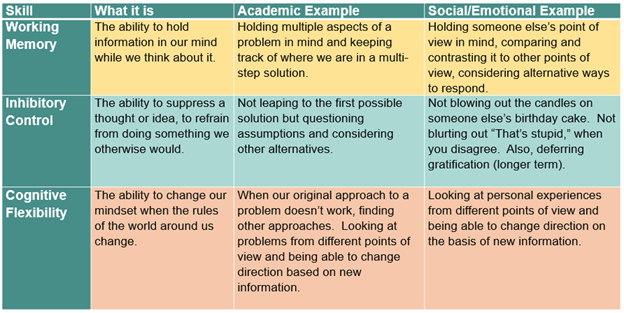As we learn about the role of cognitive skills in academic performance, we become increasingly aware of the importance of the subset of cognitive skills known as Executive Functions. Executive Functions are the directive capacities of our brains—how we manage information, plan and decide, act or stop ourselves from acting, adapt to unexpected situations.
While individual cognitive skills can be stronger or weaker, it is the elegance of the choreography, the way all these capacities integrate, flow and work together that makes up our overall intelligence.
Executive Functions play a vital role in the choreography. Sometimes people use the analogy of the orchestra conductor where the brain’s processes are the instruments in the orchestra, all coordinated by the conductor. Another analogy is an air traffic control center.
Executive Functions are how our brains organize the interplay of all myriad mental processes toward goal-directed, purposeful behavior.
Executive Functions are developed; we are not born with them fully functioning. We are born with the ability to develop them, but it takes some time for these processes to mature. Neuroscientists now say that the frontal lobes of our brains (the part of the brain right behind our foreheads), where Executive Functions are carried out, don’t fully develop until our mid-20s.
Many parents and teachers think of Executive Functions as self-regulation, and that is an important aspect of these types of cognitive skills, but there is a lot more to it than that. And like all cognitive skills, Executive Functions play a role in learning and just about everything we do in our lives.
One of the most important things to understand about Executive Functions is that they are essential in reading, math, and other academic subjects, as well as in building social and emotional competence. In other words, Working Memory is the same mental process whether we are using it to comprehend what we are reading, to solve a complex math problem, or to consider what someone else is saying and what might be causing them to say it.
There are three core Executive Functions
Working Memory
The ability to hold and manipulate information consciously in the mind.
Inhibitory Control
The ability to suppress a thought or idea and to refrain from doing something one otherwise would do.
Cognitive Flexibility
The ability to change our mindset when the rules of the world around us change, to shift between mental processes.
The chart below provides a quick overview of the role Executive Functions play in academics and social and emotional learning.

Working Memory
In reading, working memory is where we think about what we are reading, as we are reading. It is how we hold onto the beginning of the sentence or paragraph until we get to the end. It is how we compare what we are reading to what we already know, which is how we give something meaning. It is vital for comprehension, and limited working memory capacity is a culprit in many students’ ability to read fluently but seem to have little idea afterward what they read.
In math, working memory is involved in everything from copying a problem from the board or the math book to one’s paper, to counting and keeping track of which items have been counted and which haven’t. to keeping track of the steps of a complex problem.
In social situations, working memory helps us follow the train of a conversation — who has said what –as well as the general flow. It is also where we hold onto a set of instructions that someone gives us while we carry them out. Poor working memory capacity can look like a lack of attention or caring. If a child can’t remember what they were supposed to do, it can look like they don’t care, weren’t paying attention, or are just plain lazy or even obstinate.
Inhibitory Control
In reading, inhibitory control is involved in selecting among word candidates in decoding (identifying words from their written form). “Blurting” words out is due more to a lack of inhibitory control than of mere guessing, according to the research.
In math, inhibitory control is what helps us wait to multiply numbers until we’ve added the ones in parentheses or to treat a negative number differently from a positive one. It is critical for math that is non-intuitive, where we need to suppress what we think makes sense to do the mathematical analysis or apply the principle that will help us get the appropriate solution.
In social-emotional learning, inhibitory control is the quintessence of self-regulation. It keeps us from blowing out the candles on someone else’s birthday cake or from punching someone in the face when we get mad at them. It is also important in the longer-term, when we postpone immediate self-gratification for a greater goal. (Put down that doughnut!)
Cognitive Flexibility
In reading, cognitive flexibility is what enables us to switch smoothly between the brain systems we use to sound out words and to recognize sight words, to switch our attention between word meaning, grammar, syntax and overall meaning, and adapt to different characters within a narrative.
In math, cognitive flexibility is what helps us adjust when an initial approach to solving a problem doesn’t work, or to choose among a variety of possible ways to solve a problem, depending on whether we are emphasizing speed or accuracy. It is also important when the relationship to be solved for is not intuitive.
In social behavior, cognitive flexibility is what helps us stop an activity we are involved in and transition to another activity. It allows us to change our minds when we learn new information (the world is round, not flat), and to make the relevant cognitive adjustments and recognize the implications. It is what helps us recognize our mental models and consider alternative explanations for what we see happening in the world.
Measuring and Developing Executive Functions
Executive Functions are predictive of how students do academically, how much money they will earn in their careers, how healthy they will be as adults and whether or not they will have trouble with the law. And Executive Functions can be assessed and developed.
In this webinar, we explore the core executive functions – working memory, inhibitory control, and cognitive flexibility – understanding what they are and how they relate to both academic and social and emotional learning. We will show how executive functions can be measured using the Mindprint Cognitive Assessment and how they can be developed using BrainWare SAFARI cognitive training software.
About the authors
Betsy Hill is President of BrainWare Learning Company, a company that builds learning capacity through the practical application of neuroscience. She is an experienced educator and has studied the connection between neuroscience and education with Dr. Patricia Wolfe (author of Brain Matters) and other experts. She is a former chair of the board of trustees at Chicago State University and teaches strategic thinking in the MBA program at Lake Forest Graduate School of Management. She holds a Master of Arts in Teaching and an MBA from Northwestern University.
Roger Stark is Co-founder and CEO of BrainWare Learning Company. For the last decade, Stark championed the effort to bring comprehensive cognitive literacy skills training and cognitive assessment within reach of everyone. It started with a very basic question: What do we know about the brain? From that initial question, he pioneered the effort to build an effective and affordable cognitive literacy skills training tool based on over 50 years of trial & error clinical collaboration. Stark also led the team that developed BrainWare SAFARI, which has become the most researched comprehensive, integrated cognitive literacy training tool delivered online in the world. Follow BrainWare Learning on Twitter @BrainWareSafari










